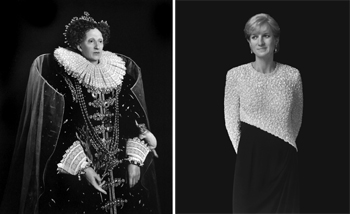
In the June issue of Colloquy, art historian Elizabeth Howie writes about discovering two ‘anonymous’ Hiroshi Sugimoto (Season 3) photographs hanging at Madame Tussaud’s Wax Museum in London. Though no labels were attached showing their authorship, the large black and white images of Lady Diana, Princess of Wales and Queen Elizabeth I near the entrance were actually part of a series of wax figure portraits Sugimoto had made at the museum in 1999.
The great fear of many artists is of course seeing one’s work die an anonymous death. Tussaud saved her own life during the French revolution through her skilled handiwork, forced to make commemorative death casts of her friends at the court of Versailles. For artists, their work ultimately becomes surrogates for the artists themselves, where paintings and sculpture (even of the wax variety) replace wax figures. In a culture and art market where celebrity artists are common in a parallel universe to Hollywood, it is particularly odd and fascinating to consider the predicament of anonymity within a museum context.
If every art museum were burned to the ground as Malevich and the Futurists had hoped, leaving merely traces of what was once “grand” in only public spaces and kitschy museums such as Madame Tussaud’s, then even stranger to discover the possibility that the artist may survive as somewhat of a “nameless soldier” in a tomb to the history of celebrity.
Will the fate that stricken the artist named “School of Rembrandt” or “Follower of Velasquez” one day befell the rest of us as well as Sugimoto himself, who ironically considered Madame Tussaud’s a place he wouldn’t normally visit as an art viewing experience, “but always with my work in mind”?



